Cucumbers are tender annuals that love warm climates to develop at their best. Though these plants are hardy plants, at some point, they will face some issues. So, today’s article is about the common problems cucumbers face and how to encounter them.
The cucumbers will have several problems like stunted growth, yellow or brown leaves, wilted leaves, seeds not germinating, seedlings rotting or looking sad, no fruits, overcrowding, holes in the leaves, and white or target spots.
Common problems with cucumber plants include pests, diseases, and environmental stress. Pests such as aphids and cucumber beetles can damage plants, while diseases such as powdery mildew and bacterial wilt can cause wilting. Environmental stress, such as heat and drought, can also affect plant growth.
Even if you take good care of your cucumbers, they will have these issues one day. If you have encountered any problems, this is the right place to find the solutions. We have covered all the problems you will likely face when growing cucumbers and their solutions.
1. Stunted growth or slow vine growth
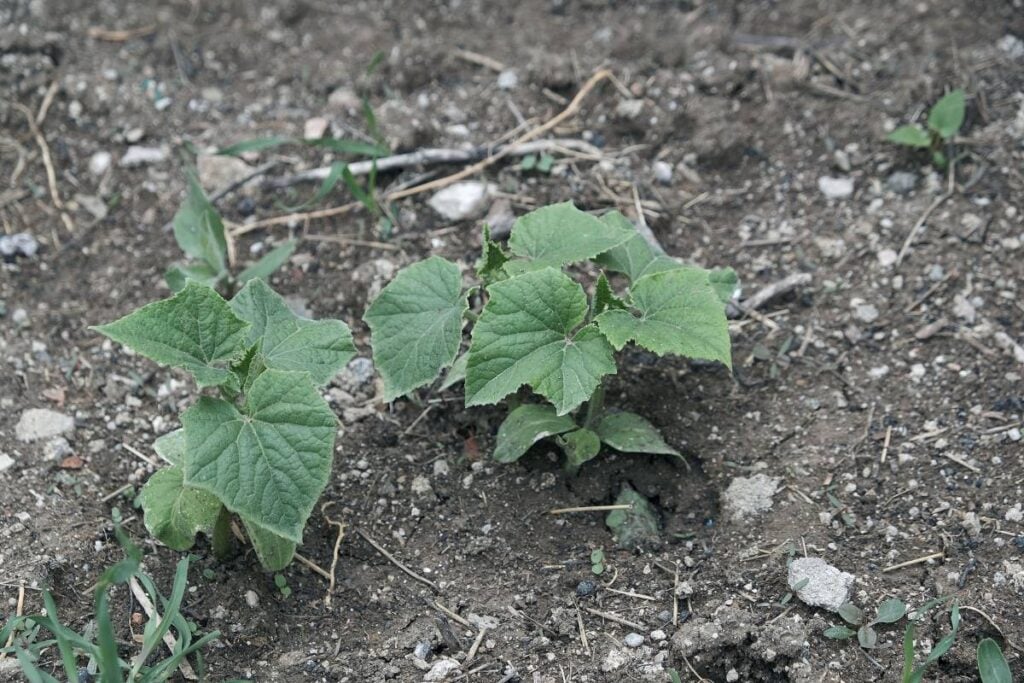
Stunted growth is typically a sign that you have made a mistake related to soil, moisture, or nutrients.
If you observe the plant keenly, you will find it develops slowly.
Check the soil, fertility, and moisture levels if you find stunted or slow growth.
Soil quality
Cucumbers will not love compact and heavy soil.
The ideal soil type is well-drained, loamy, and nutrient-rich soil.
With compact soil, the roots will struggle to spread and breathe oxygen.
As a result, the plant will struggle to grow or grow very slowly.
If the soil is the problem, touch it and check its compactness.
Use a fork and carefully loosen the soil if you find it compact.
Add some organic matter like compost to improve the drainage.
You can add earthworms to the soil when planting.
As they move, they aerate the soil, and their excretion adds nutrients.
Fixing the soil can be difficult once the plants are established in the ground.
So, you must be careful and gentle while loosening the soil.
Fertilizer
As I have mentioned, cucumbers love nutrient-rich soil.
They are heavy feeders.
Weak vines, stunted or slow growth, and yellow leaves indicate the soil is not fertile.
Yellow leaves are a sign of potassium deficiency.
Unlike other plants, cucumbers need low nitrogen and high potassium and phosphorus.
Use a balanced fertilizer with NPK 10-10-10 to fix the potassium deficiency.
Use fertilizers with NPK 2-3-6 or 3-6-6 for regular use.
For liquid fertilizers, apply it once every 2 weeks.
For slow-release, use it every month.
If you see signs of under-fertilization, use fertilizer in small amounts.
Begin with half of the recommended strength.
When the plant starts growing at its full potential, gets filled with flowers and fruits, stop fertilizing them.
Lack of moisture
Cucumbers are 96% water, and they are very thirsty.
Without enough water, there will be no growth in the plant.
Check the soil and leaves if you find stunted growth in the plant.
If the soil feels dry deep down a few inches and the leaves have also become thin, it is confirmed that the plant is not receiving enough water.
Water the plant every week with 1-2 inches of water.
Water them 2-3 times per week during the hottest times of the month.
Add a bit of straw as mulch around the plant to keep the moisture from evaporating during the scorching summers.
Your plant should start growing after a few days.
Poor planting techniques
Cucumbers are easy to grow.
But they do not like their roots to be disturbed. So, when you transplant them, you need to be very careful.
Due to transplant shocks, the plant will have stunted growth and struggle with physiological disorders.
That is why it is better to sow the seeds directly into the soil instead of starting them indoors.
If you need to transplant, be careful and patient.
Take care of the plant and give it time to adjust to the new environment.
If your region has cold weather and a short growing season, grow fast-maturing cucumbers.
2. Yellow leaves
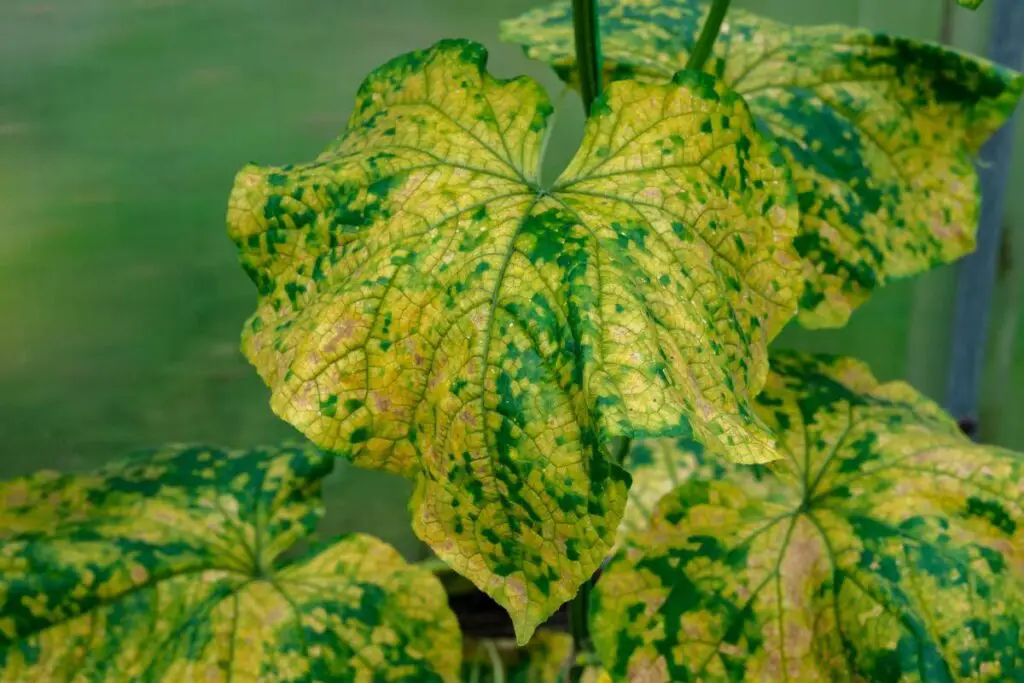
When the leaves become pale yellow, the plant cannot produce enough chlorophyll.
The chlorophyll gives the leaves vibrant colors, allowing the plant to make food with photosynthesis.
When the leaves turn yellowish, it does not produce enough chlorophyll.
Additionally, the plant won’t be able to photosynthesize and produce juicy fruits.
The reasons behind the discoloration are inconsistent watering, nutrient deficiencies, and lack of sunlight.
Watering
The cucumbers should be watered consistently to stay evenly moist all the time.
Inconsistent watering will not only turn the leaves yellow but also make the cukes bitter to taste.
The best way to maintain evenly moist soil is by checking the moisture level regularly or attempting drip irrigation.
While checking the moisture level, water them whenever the top few inches have dried.
In drip irrigation, the soil remains consistently moist, reducing water wastage.
Nutrient deficiency
Cucumbers will indeed need less nitrogen than potassium and phosphorus.
But it will still need some amount of nitrogen for vegetation growth.
To add nitrogen, add a few tablespoons of fertilizers.
Follow the instructions on the label, and don’t use it too much.
Cucumbers need a high dose of potassium for flowering.
If there is a potassium deficiency, use a balanced fertilizer with NPK 10-10-10.
For iron deficiency, spray the leaves with liquid iron or spray-grained iron around the roots in little amounts.
Make sure to feed your plant at 3 specific times:
- Add organic matter before planting
- Add fertilizers while mulching after planting
- Fertilize with slow-release every month or liquid fertilizer every 2 weeks for 8 weeks.
Sunlight issues
Ensure the plants receive at least 6 to 8 hours of sunlight daily for enough chlorophyll.
Otherwise, you will witness yellowing within no time.
Also, sunlight should not be too intense, which causes sunburns and yellowing.
If the intensity is too much, shade the plant only during the hottest time, i.e., from 11 am to 3-4 pm.
Pests
Sometimes, sap-sucking pests like aphids, whiteflies, and spider mites can also cause yellow leaves.
They suck out all the moisture from the leaves, leading to yellowing.
Check the plant and see if you find any pests under the leaves.
If there is, isolate it from the other plants.
Shower the plant to dislodge them from the plant.
Add some neem oil or insecticidal soaps to treat the plant.
Looking for gardening supplies? We have tested 100's of products before recommending them to you guys. Check out our best pick below:
| Image | Gardening Supplies | Best Price? |
|---|---|---|
 Top
Top Top
Top | Raised Garden Bed Kit | Check On Amazon |
 | XLUX Soil Moisture Meter, Plant Water Monitor, Soil Hygrometer Sensor for Gardening, Farming, Indoor and Outdoor Plants, No Batteries Required | No Results |
 Top
Top Top
Top | 82 Pcs Garden Tools Set and Extra Succulent Tools Set | Check On Amazon |
 | Joeys Garden Expandable Garden Hose with 8 Function Hose Nozzle, Lightweight Anti-Kink Flexible Garden Hoses, Extra Strength Fabric with Double Latex Core, (50 FT, Black) | No Results |
 Top
Top Top
Top | Dual Chamber Compost Tumbler | Check On Amazon |
 Top
Top Top
Top | Sunnyglade Plant Stakes | Check On Amazon |
 Top
Top Top
Top | Organic Cold Pressed Neem Seed Oil | Check On Amazon |
 Top
Top Top
Top | Mighty Mint Gallon :-Insect and Pest Control Peppermint Oil | Check On Amazon |
 Top
Top Top
Top | Scotts DiseaseEx Lawn Fungicide | Check On Amazon |
 Top
Top Top
Top | Jacks Classic 20-20-20 All Purpose Fertilizer | Check On Amazon |
 Top
Top Top
Top | 30,000 Seeds Pollinator Attracting Wildflower Mixture | Check On Amazon |
 Top
Top Top
Top | Survival Vegetable Seeds Garden Kit-Over 16,000 Seeds | Check On Amazon |
3. Leaves dying
Two primary reasons behind this are moisture scarcity and pests and diseases.
Lack of moisture
The cucumbers are 96% moisture, grow fast, and thus need plenty of water.
Without enough moisture, the leaves will wilt and die.
And this is the case mainly in the hot summers when the temperature crosses 90 to 95°F.
So, keep an eye on the cucumber plants, especially the soil.
Check the moisture level regularly before watering.
Whenever the top few inches have dried, water the plant in the early morning or after the sun goes down.
You must irrigate the soil to the root level to revive the plant quickly.
Pests and diseases
The sap-sucking pests suck out all the moisture from the leaves, and the leaves become dry and die.
Some will eat the leaves and their tissues.
Over time, the fruits will also get damaged.
Some pests responsible for dead leaves are aphids, spider mites, cucumber beetles, and squash bugs.
These mostly attack the cucumber plants to feed on their leaves and juicy fruits.
Diseases like bacterial wilt and powdery and downy mildew will also kill the leaves.
The bacterial wilt disease will lead to a rapid wilting of the leaves, eventually killing them.
The powdery or downy mildew will start with spots on the leaves, ultimately progressing to browning and dead leaves.
Other diseases leading to dead leads are anthracnose, leaf spot, and blight.
To prevent pest and disease infestation, pay attention to the hygiene and cleanliness of your garden.
Keep the surroundings clean, remove all the weeds and debris, and add mulch around the cucumbers to retain moisture and suppress weed growth.
When you see signs of pests, spray some neem oil or insecticides on the plant.
For diseases, use copper fungicides and avoid stressing the plant further.
Avoid overhead watering.
4. Dry and brown leaves
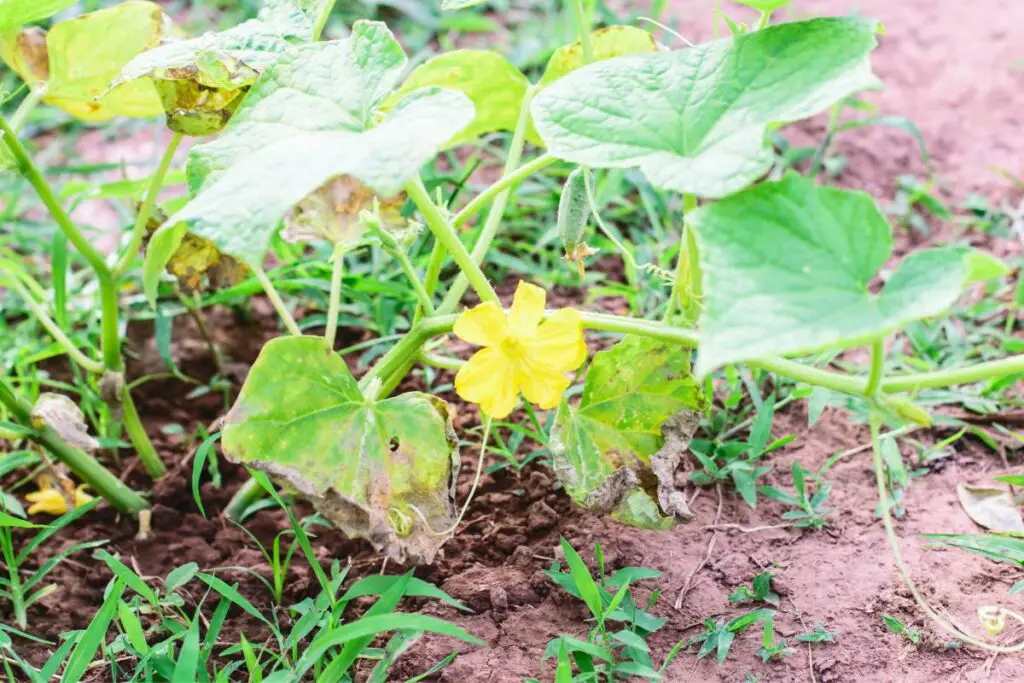
When I first saw dry and brown leaves, the first thing that hit my mind was the lack of moisture.
I checked the soil and watered the plant. After a few days, the plant was okay.
The thoroughly dried leaves fell off, but the partially affected leaves revived slightly.
Besides these, diseases can also lead to dry and brown leaves.
Lack of moisture
When you do not provide enough moisture to the cucumber plants, they will become weak and try to inform you with signs like dry, thin, and discolored leaves.
The cucumbers are shallow-rooted plants with one taproot.
So, they suffer from drought faster than most plants.
Provide them 1-2 times weekly with 1-2 inches of water.
Increase the watering based on the weather conditions.
Diseases
Diseases like Verticillium wilt and Angular leaf spot also lead to dry and brown leaves.
The Verticillium wilt’s initial signs are yellowing and browning with wilted leaves.
Over time, the browning will progress to a cross-section of the roots.
The entire plant will die if you don’t treat it.
Unfortunately, you cannot treat the disease. You have to destroy all the plants affected by Verticillium wilt.
As the name suggests, the leaves will have angular spots in Angular leaf spot disease.
The spots will be dry and brittle.
These spots will fall off and create large irregular holes.
Luckily, you can control this disease when the surrounding is dry.
Water the plant only when it needs and maintain distance between each plant for adequate airflow.
For prevention, shift the cucurbit families every 2 years to a new location in your garden.
5. Wilted leaves
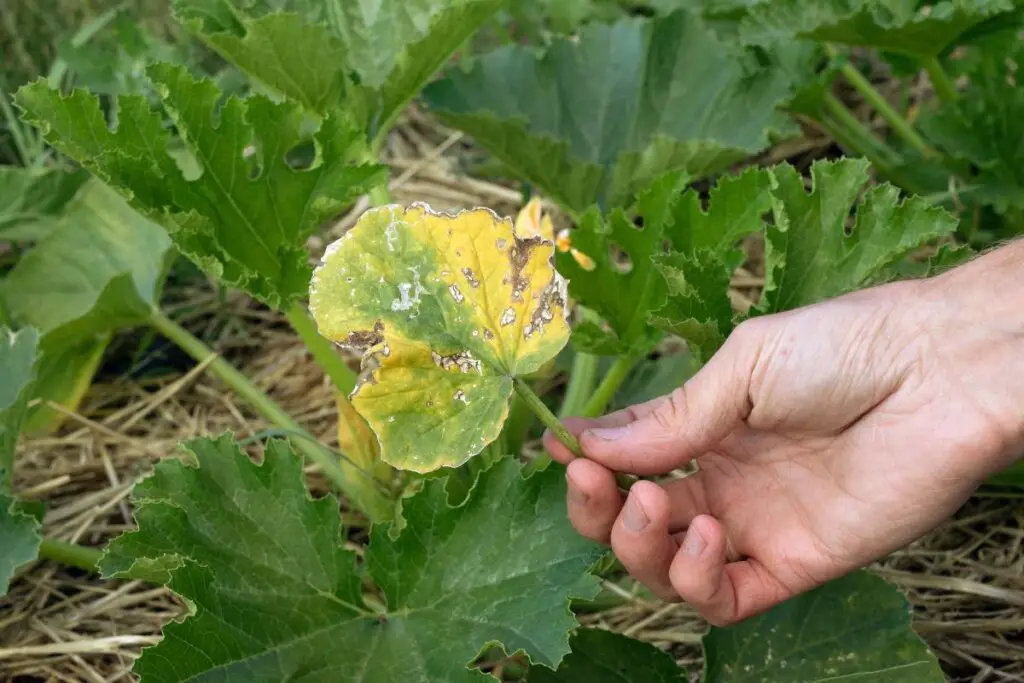
Besides pests and diseases, heat stress can also sometimes lead to wilted leaves.
Heat stress
The cucumbers need warm temperatures around 75 to 85°F.
Above 90 to 95°F will lead to heat stress.
As a result, the leaves will wilt, curl, and dry out.
When you see such signs, provide enough water, add mulch to preserve the moisture in the soil, and shade the plant during the hottest time of the day.
Pests and diseases
Diseased plants are challenging to solve.
So, you must prevent it by growing disease-resistant plants and keeping the surrounding neat and clean.
Spray neem oil whenever you spot any pests in your plant.
Along with wilting, the leaves will feel sticky to the touch.
Sometimes, nematodes are the reason behind wilting.
They feed on the roots for which the plant cannot receive enough moisture, leading to wilting.
Prevention is better than cure here.
If the roots get damaged, it becomes impossible for the plant to survive.
To prevent this, consider crop rotation every 1-2 years.
Solarize the soil with a plastic sheet.
Spread it firmly over the soil for 4-6 weeks during the summer heat.
The high heat will kill all the nematodes.
6. Sudden wilting in the vines
If the cucumber vines are wilting suddenly, it is affected by bacterial wilt.
It is the only disease that leads to sudden wilt.
Despite enough moisture levels, you will see the following signs:
- Dull leaves
- Wilting during the day and recovering at night
- Yellow and brown margins in the leaves
- Wilting progressing to the vines rapidly
- Slowly, all the leaves and vines are wilting
- Presence of too many striped cucumber beetles
- Leaves dying
When you see these signs, it is evident that your cucumber plant is suffering from bacterial wilt.
Unfortunately, there is no such cure to treat the disease.
Remove the plant immediately to stop it from spreading to the other plants.
To prevent the problem further, plant disease-resistant varieties, for example, Country Fair, Little Leaf-19, and Cross Country.
7. Sad and wilted when transplanted
Though the cucumbers are easy to grow, they hate getting transplanted suddenly.
When their taproot gets disturbed while transplanting, the plant gets stressed and will display the following signs:
- Excessive wilting despite caring for the plant and not getting infested.
- Yellow or white pale leaves
- Sad looking plants
- Seedlings falling off
Preventing transplant shock needs extra care, maintenance, and hardening.
Cucumbers get established quickly, but not as fast as tomatoes and other vegetables.
For happy and healthy transplants:
- Use loamy and well-drained soil with lots of organic matter.
- Be gentle while removing and transplanting the seedlings to the garden.
- Do not transplant the cucumber plants too early. The right time to transplant the seedlings is 2-4 weeks after the seedling starts growing.
- Harden them before transplanting by exposing them to outdoor elements regularly, and increase the timing of exposure gradually.
- The roots should be firm and well-established to hold the plant on the soil and fight any problems.
- Water the seedlings with a diluted kelp solution to reduce the shock.
- Transplant them early morning or evening when the sun is not intense, and the weather is cool.
- Cover them with row fabric to insulate them during temperature fluctuations.
If the shock is too bad, you have to replant or sow new seeds directly in the garden again to avoid the transplanting issue.
8. Seeds not germinating
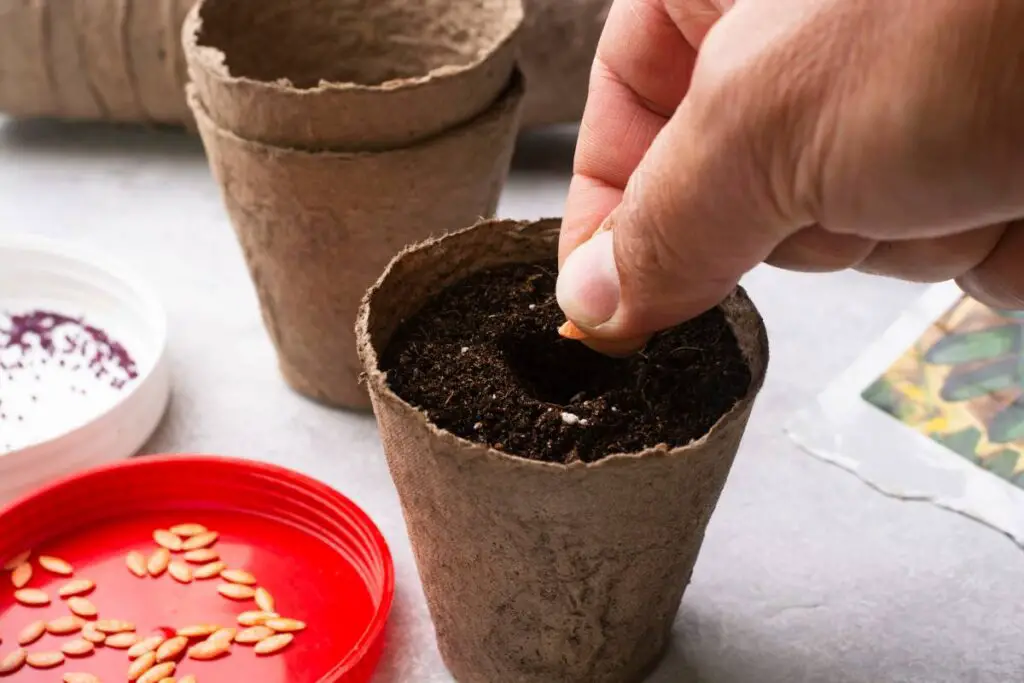
While sowing the seeds directly in the soil, you need to consider many factors, like depth, the temperature of the soil, seed age, etc.
If these factors are ignored, your cucumber seeds will never germinate.
Failed germination commonly happens with beginners.
Seed depth
Beginners have a misconception that you can toss the seeds into the soil aimlessly.
But that is not the case.
You must maintain the space and depth when you sow the seeds directly into the soil.
Planting them too deep will take them forever to germinate, leading to a lack of endosperm.
Additionally, shallow planting will make them float away when watered or exposed to sunlight or rain.
Maintain 24 inches of distance between each seed.
So for proper germination, the seeds should be planted twice as deep as their dimensions.
Sow them at least ½ to 1 inch deep into the soil.
Seed age and condition
Cucumber seeds are viable for only a few years.
Old seeds do not germinate or germinate only erratically or unevenly.
The cucumber seeds last for 6 years, provided they are kept under favorable conditions, like cool, dark, and dry places. Pelleted seeds last for one year.
Don’t expect germination if the seeds’ lifespan has ended.
With new seeds, you get the highest germination rate.
Soil temperature
These tender annuals love warm temperatures to grow and develop well.
The seeds do not like cold weather and hence won’t germinate if the soil temperature has not warmed up yet after the winter.
The soil temperature needs to be around 65°F.
Seeds will not germinate if the temperatures are below 55 to 60°F.
If you are sowing them directly in your garden, check the soil temperature with a thermometer and ensure it is at least 65 to 70°F.
If you are sowing them early, use a heat map to warm the germination tray’s pot by 70-75°F.
Moisture
When sowing the seeds, you need to provide them with adequate moisture but not soak the soil too much.
The soil needs to be evenly moist and not wet.
Overwatering is a common problem in cucumber plants.
Since these plants love moisture, gardeners think providing too much water is okay.
While it is valid for plants, you must be patient and careful with the seeds.
Check the soil regularly to ensure you keep evenly moist soil and not too wet or dry.
Water the seeds whenever the top few inches have dried, and thoroughly until the water comes out of the drainage hole.
If the seeds are directly sown in the garden, cover them with a row of fabric to retain the moisture for the seeds to germinate.
Rodents
Rodents love cucumber seeds.
If you discover that the cucumber seeds in your garden are not emerging, they got eaten or dug up.
Examine the surrounding area of the seeds to check for holes.
If there are, rodents have probably eaten or dug them up.
Cover the seeds with a tarp for 3-5 days to keep your garden rodent-free.
Set a peanut butter mouse trap and pull off the tarp when the seeds germinate.
You can also add some hardware cloth to make a cage around the seeds or plant some companions that deter such pests.
9. Seedlings rotting at the base
Sometimes, the seeds germinate well, but the seedlings rot at the base.
The stems will have a white, brown, and skinny appearance.
These cucurbits are susceptible to a seedling disease called damping off caused by pathogens like Pythium, Rhizoctonia, and Fusarium.
These pathogens live in excessively moist and humid conditions.
If the seedlings rot at the base because of the disease, something has gone wrong at the start of the seed sowing.
You cannot save the seedlings from dying, but you still have time to sow other seeds if you have any.
To prevent the disease from occurring:
- Maintain enough airflow to reduce the humidity levels.
- Plant your seeds at a breezy spot in your garden. Keep the indoor cucumbers near a breezy window.
- Avoid over-watering the seeds.
- Use well-drained, loamy, and nutrient-rich soil. Add perlite, vermiculite, compost, or peat moss to the soil mixes.
- Sanitize the gardening tools before and after usage. Keep the surroundings neat and clean.
This disease occurs only during the seedling stage. Once that passes, your plants are free from this disease.
10. Holes in the leaves
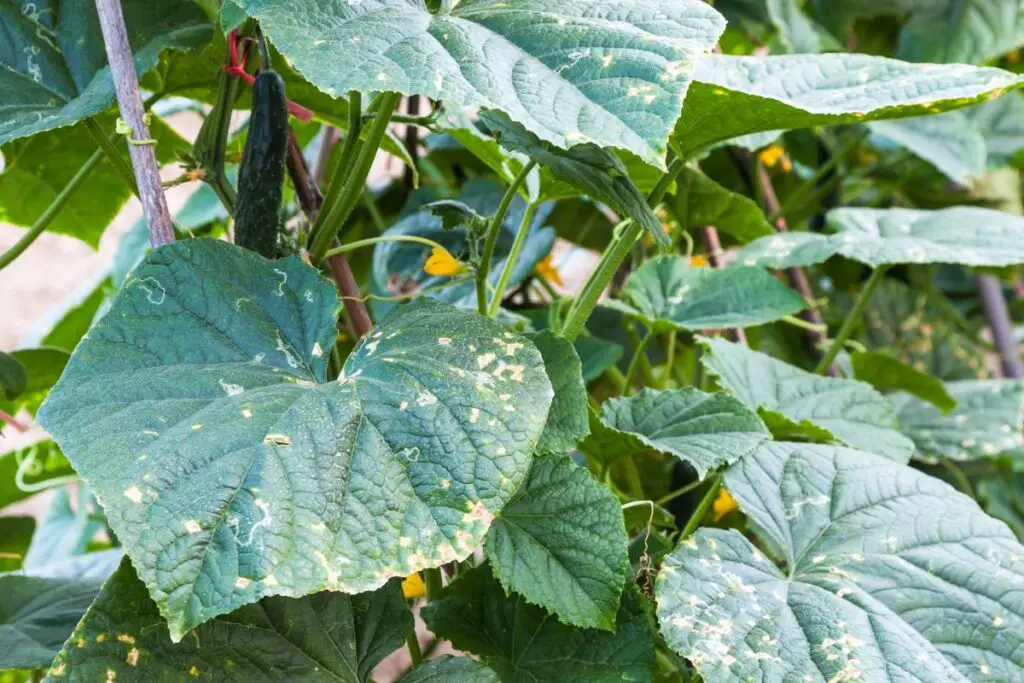
Many pests, like fleas and cucumber beetles, can attack cucumber plants and create holes in the leaves.
Flea beetles
The flea beetles measure ⅛ inch long, have metallic-colored bodies, and their feeding patterns will give the cucumber leaves a million holes.
Once the plant tissue decays, these holes become yellow or brown rings.
The damage becomes severe in the spring.
To get rid of these pests, use neem oil or put up yellow sticky traps to trap them when they try to reach the cucumber leaves.
Also, plant some companions that will attract beneficial predators to feed on these bugs.
However, if you want to attract these predators, avoid pesticides.
Cover the newly transplanted cucumbers with a light-row cover to keep the pests at bay.
Cucumber beetles
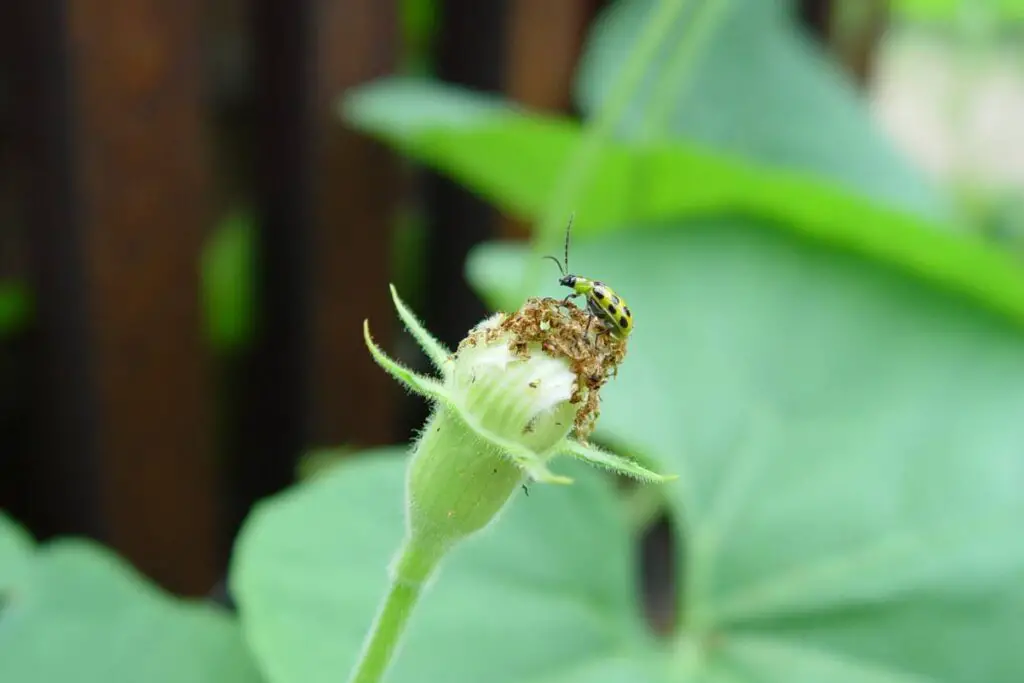
These bugs are common in cucumbers and other cucurbit families.
They have striped backs with yellow and black color.
The bugs feed on the leaves and create holes.
They also feed on the flowers and fruits.
The bugs can badly damage the plants more than the other pests and encourage diseases like bacterial wilt and mosaic virus.
The reduction method of these pests is the same as the flea beetles.
Use neem oil, yellow sticky traps, and plant companions to attract beneficial predators, or use pesticides and insecticidal soaps.
11. No fruit production or lack of pollination
There are two common reasons behind the problem, for example:
- You have only male or only female flowers.
- There are no pollinators in your garden.
The cucumbers grow male flowers in the early flowering season, and the female flowers come late.
Monoecious varieties grow both male and female flowers.
But, if the weather is warm, the cucumbers will grow only male flowers.
The female flowers will need slightly cool weather to bloom.
In hot climates, there will be a delay in the female flower growth.
As a result, there won’t be any pollination.
You will have only female flowers if you have grown only gynoecious varieties.
The best option is to grow monoecious varieties with some gynoecious varieties.
If the monoecious varieties have only male flowers, they can be cross-pollinated with the gynoecious varieties.
There is a lack of pollinators if you have suitable varieties but no fruit production.
Cucumbers pollinate when the bees or winds carry the pollen from the male flower and put it inside the female flower.
In that case, hand-pollinate them.
Take a brush or cotton swab, take the pollen from the male flower, and rub it to the female flower.
Or, break the male flower and rub it against the female flower.
Do not feel guilty; the male flower will fall off automatically after pollinating.
Plant plants that attract pollinators, like nasturtiums, sunflowers, yarrow, alyssums, and marigolds.
12. Rotten fruits on the ground
When the cucumbers are grown in the ground, they roll over the ground.
If you see rotten fruits in the plants, the reason is excessive irrigation and rainfall.
Other reasons are rodents and fungi.
Stop letting them touch the ground by growing them in a trellis.
It will keep the fruits above the ground and prevent rotting.
13. Overgrowing of the vines
Since the cucumbers are vining varieties, they become uncontrollable once they grow.
Over time, the vines and leaves will thrive and lead to overcrowding.
Overcrowding of the vines will make it challenging to harvest.
While walking around the vines, you might trip and fall off or step on the cucumbers mistakenly.
Again, trellis is the best solution. With little training, the plant will grow upwards and give you enough space to walk about and harvest the cucumbers.
14. Too many stems and leaves but low yields
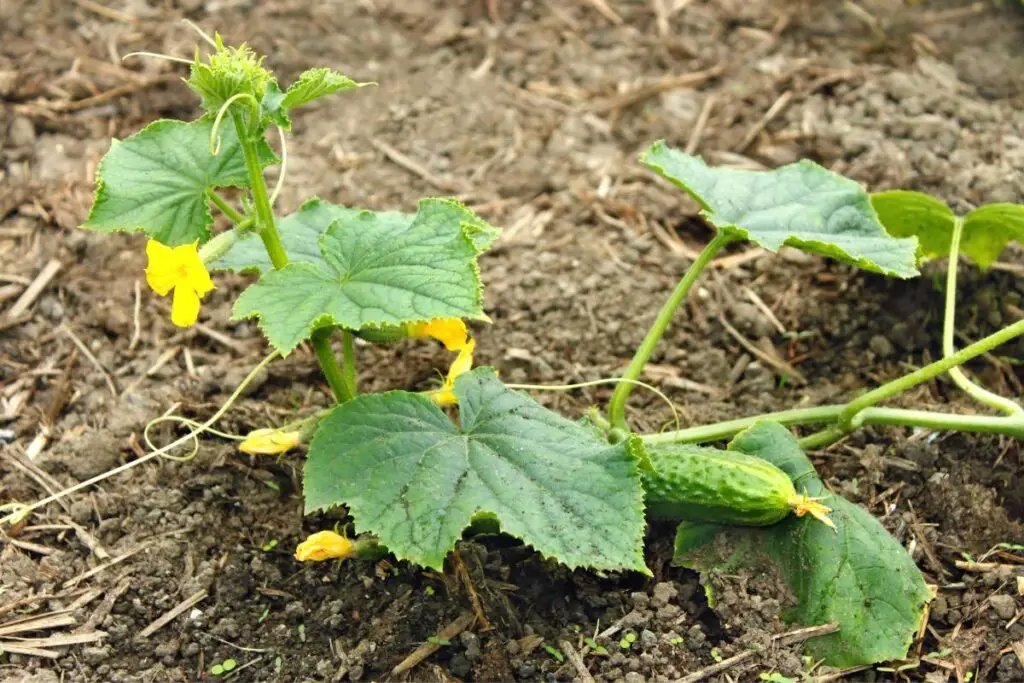
As I mentioned, cucumbers are fast growers.
Their stems and leaves will grow actively once they develop well.
The stems and leaves can suck away all the resources you provide them.
As a result, there is rarely anything left for the flowers and fruits.
You will see only vines and leaves and not fruits.
The solution is pruning. When you prune some leaves, the plant can use the nutrients and moisture to produce flowers and fruits.
Aim for the lower leaves and make sure not to prune too much.
Excessive pruning will lead to a few leaves and further stress the plant.
Prune the cucumbers to increase the fruit production by 2-3 times.
15. Target-shaped spots
The cucumbers do not enjoy windy, damp, and humid weather.
Target-like spots in your cucumber leaves suggest Angular leaf spot disease caused by Pseudomonas syringae bacteria.
When the disease attacks your plant, you will have signs like:
- Round, angular cream spots
- Yellowing around the spots
- Spots bound with leaf veins
- The center of the spot is dry and has dropped off, giving a target-like appearance
- Dry leaves and premature defoliation
Isolate the plant, remove the infected leaves, and burn the crop residue.
Prevention by cultural control is the best way to control the disease:
- Use drip irrigation and avoid overhead watering.
- Practice crop rotation and keep your garden neat and clean. Get rid of all the debris and weed.
- Add mulch around the plant to suppress the weed growth and retain moisture in the soil to avoid too much watering.
- Grow disease-resistant and certified disease-free seed varieties, for example, Citadel, Bristol, and Little Leaf.
16. Shriveled brown or black leaves
Cucumbers love warm weather and hate cold weather.
If the cucumber leaves have withered and turned brown or black after a cold night in winter, the plant has cold damage.
If the cold damage is light, the cucumber leaves will only appear to be wilt.
But in worse conditions, the leaves will wilt and die.
If the weather is below 50-55°F, you must protect the outdoor cucumbers.
Cover them with frost blankets and row covers.
You will commonly witness cold damage in your plants during spring because the last frost occurs in spring.
If you have started cucumbers indoors, transplant them outdoors 2-3 weeks after the last spring frost and when the soil temperature rises to at least 60-65°F.
These shriveled brown or black leaves will dry and fall off after some time, or you can remove them.
17. White powder-like spots
These spots indicate powdery mildew caused by the fungus Podoshphaera Xanthii.
Other symptoms are:
- Dusty gray leaves
- White blotches
- Fuzzy appearance on the stem
- Yellowing
- Wilting
- Rotting
The disease is common in all plants and occurs when the surrounding is too damp and humid.
Unlike other diseases, fixing this disease is manageable.
Use neem oil or any horticulture oil.
You can try a homemade spray.
Mix 1 tablespoon of baking soda, 1 tablespoon of vegetable oil, and 1 teaspoon of natural dish soap.
Add this mixture with one gallon of water.
Spray this mixture directly on the affected parts.
Another option is to add 2-3 tablespoons of vinegar with 1 gallon of water. Use this in the evening.
For prevention, grow mildew-resistant varieties like Indy, Thunder, and Alibi.
Final thoughts
Cucumbers are easy to grow, but they will face these problems if you make mistakes. So, please provide them with their optimal requirements for better results.
If your cucumber faces any issues, immediately fix them and prevent them from spreading further. In most cases, the problem begins with wilting or yellowing.
Take steps at the initial stage to prevent the plant’s condition from worsening, fix the problem faster and keep it healthy.
Do cucumber fungi survive in the soil?
Yes, cucumber fungi can survive in the soil. So, you must be careful and consider crop rotation to avoid diseases in your plant. Additionally, avoid planting any susceptible varieties or plants in the area where the disease has already occurred.
Should I grow cucumbers on the ground or trellis?
Trellis is the best option as it keeps your plant and the cucumbers above the soil and can prevent several diseases. Also, the cucumbers will receive enough space to grow their vines, and you will get enough room in your garden to grow other varieties.
Reference: Cucumber Wikipedia
